非线性最小二乘法Levenberg-Marquardt method
- 格式:doc
- 大小:220.50 KB
- 文档页数:11
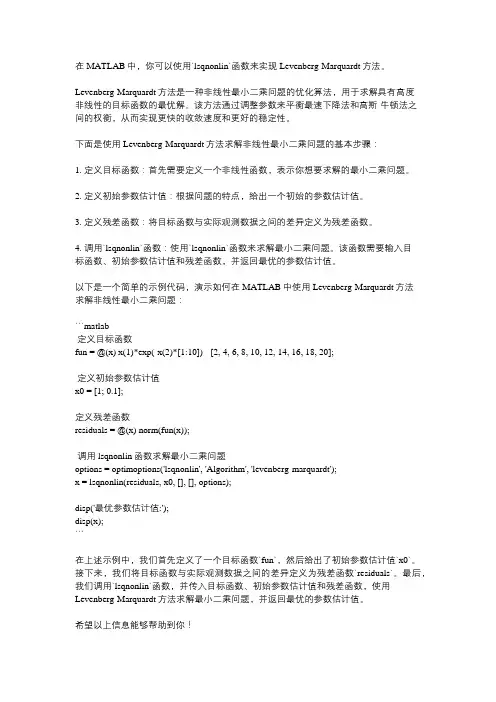
在MATLAB中,你可以使用`lsqnonlin`函数来实现Levenberg-Marquardt方法。
Levenberg-Marquardt方法是一种非线性最小二乘问题的优化算法,用于求解具有高度非线性的目标函数的最优解。
该方法通过调整参数来平衡最速下降法和高斯-牛顿法之间的权衡,从而实现更快的收敛速度和更好的稳定性。
下面是使用Levenberg-Marquardt方法求解非线性最小二乘问题的基本步骤:1. 定义目标函数:首先需要定义一个非线性函数,表示你想要求解的最小二乘问题。
2. 定义初始参数估计值:根据问题的特点,给出一个初始的参数估计值。
3. 定义残差函数:将目标函数与实际观测数据之间的差异定义为残差函数。
4. 调用`lsqnonlin`函数:使用`lsqnonlin`函数来求解最小二乘问题。
该函数需要输入目标函数、初始参数估计值和残差函数,并返回最优的参数估计值。
以下是一个简单的示例代码,演示如何在MATLAB中使用Levenberg-Marquardt方法求解非线性最小二乘问题:```matlab定义目标函数fun = @(x) x(1)*exp(-x(2)*[1:10]) - [2, 4, 6, 8, 10, 12, 14, 16, 18, 20];定义初始参数估计值x0 = [1; 0.1];定义残差函数residuals = @(x) norm(fun(x));调用lsqnonlin函数求解最小二乘问题options = optimoptions('lsqnonlin', 'Algorithm', 'levenberg-marquardt');x = lsqnonlin(residuals, x0, [], [], options);disp('最优参数估计值:');disp(x);```在上述示例中,我们首先定义了一个目标函数`fun`,然后给出了初始参数估计值`x0`。
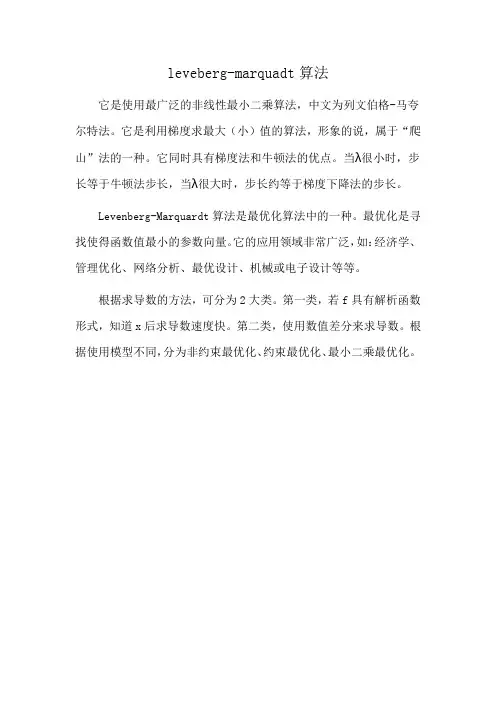
leveberg-marquadt算法
它是使用最广泛的非线性最小二乘算法,中文为列文伯格-马夸尔特法。
它是利用梯度求最大(小)值的算法,形象的说,属于“爬山”法的一种。
它同时具有梯度法和牛顿法的优点。
当λ很小时,步长等于牛顿法步长,当λ很大时,步长约等于梯度下降法的步长。
Levenberg-Marquardt算法是最优化算法中的一种。
最优化是寻找使得函数值最小的参数向量。
它的应用领域非常广泛,如:经济学、管理优化、网络分析、最优设计、机械或电子设计等等。
根据求导数的方法,可分为2大类。
第一类,若f具有解析函数形式,知道x后求导数速度快。
第二类,使用数值差分来求导数。
根据使用模型不同,分为非约束最优化、约束最优化、最小二乘最优化。
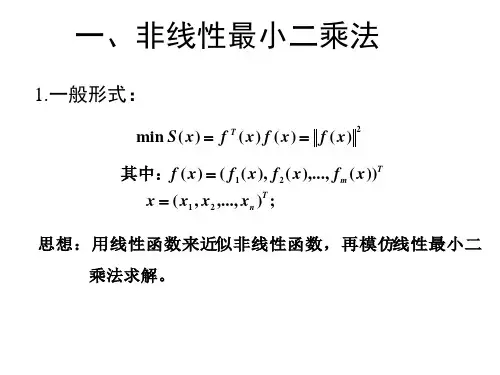

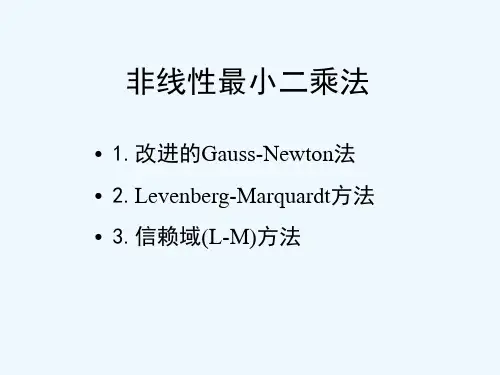
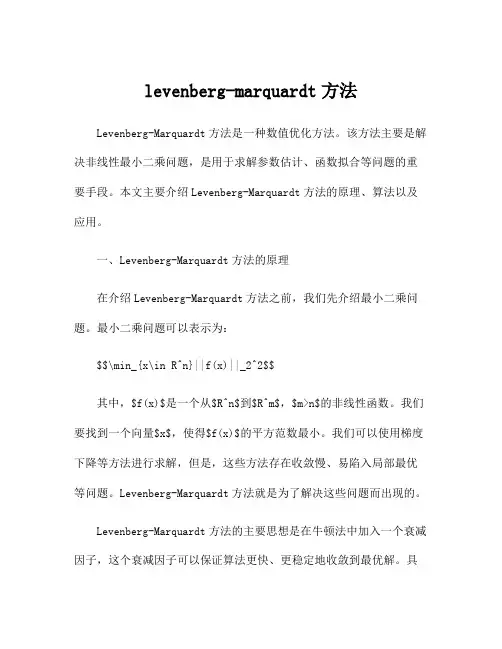
levenberg-marquardt方法Levenberg-Marquardt方法是一种数值优化方法。
该方法主要是解决非线性最小二乘问题,是用于求解参数估计、函数拟合等问题的重要手段。
本文主要介绍Levenberg-Marquardt方法的原理、算法以及应用。
一、Levenberg-Marquardt方法的原理在介绍Levenberg-Marquardt方法之前,我们先介绍最小二乘问题。
最小二乘问题可以表示为:$$\min_{x\in R^n}||f(x)||_2^2$$其中,$f(x)$是一个从$R^n$到$R^m$,$m>n$的非线性函数。
我们要找到一个向量$x$,使得$f(x)$的平方范数最小。
我们可以使用梯度下降等方法进行求解,但是,这些方法存在收敛慢、易陷入局部最优等问题。
Levenberg-Marquardt方法就是为了解决这些问题而出现的。
Levenberg-Marquardt方法的主要思想是在牛顿法中加入一个衰减因子,这个衰减因子可以保证算法更快、更稳定地收敛到最优解。
具体而言,Levenberg-Marquardt方法将牛顿法中的Hessian矩阵加上一个一定的正定矩阵,这个正定矩阵的大小可以动态调整。
当这个矩阵的大小较小时,Levenberg-Marquardt方法就相当于梯度下降法;当这个矩阵的大小较大时,Levenberg-Marquardt方法就相当于牛顿法。
这个正定矩阵的大小可以通过迭代过程中的误差大小来动态调整。
二、Levenberg-Marquardt方法的算法Levenberg-Marquardt方法的算法可以表示为:输入:函数$f(x)$,初值$x_0$,最大迭代次数$maxIter$,误差容限$eps$,衰减因子$\lambda$,正定矩阵$J^TJ$。
输出:使得$f(x)$的平方范数最小的解$x$。
1.令$x=x_0$,$k=0$。
2.计算函数$f(x)$在$x$处的梯度$g_k=J_k^T(y_k-f_k)$,其中$y_k$是$f(x)$的近似值,$J_k$是$f(x)$在$x$处的雅可比矩阵,$f_k=f(x_k)$。
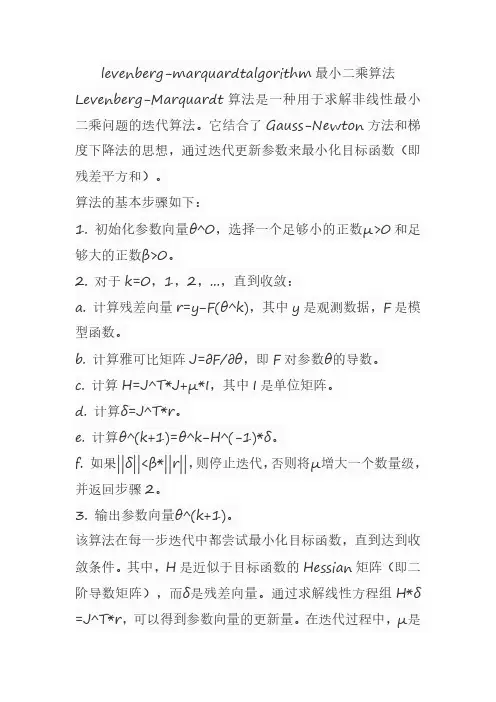
levenberg-marquardtalgorithm最小二乘算法Levenberg-Marquardt算法是一种用于求解非线性最小二乘问题的迭代算法。
它结合了Gauss-Newton方法和梯
度下降法的思想,通过迭代更新参数来最小化目标函数(即
残差平方和)。
算法的基本步骤如下:
1.初始化参数向量θ^0,选择一个足够小的正数μ>0和足够大的正数β>0。
2.对于k=0,1,2,...,直到收敛:
a.计算残差向量r=y−F(θ^k),其中y是观测数据,F是模型函数。
b.计算雅可比矩阵J=∂F/∂θ,即F对参数θ的导数。
c.计算H=J^T*J+μ*I,其中I是单位矩阵。
d.计算δ=J^T*r。
e.计算θ^(k+1)=θ^k−H^(-1)*δ。
f.如果||δ||<β*||r||,则停止迭代,否则将μ增大一个数量级,并返回步骤2。
3.输出参数向量θ^(k+1)。
该算法在每一步迭代中都尝试最小化目标函数,直到达到收
敛条件。
其中,H是近似于目标函数的Hessian矩阵(即二
阶导数矩阵),而δ是残差向量。
通过求解线性方程组H*δ=J^T*r,可以得到参数向量的更新量。
在迭代过程中,μ是
一个阻尼因子,用于控制Hessian矩阵的近似精度。
如果迭代不收敛,则将μ增大一个数量级,以增加阻尼效果。
Levenberg-Marquardt算法在许多领域都有广泛的应用,例如曲线拟合、图像处理、机器视觉、控制系统等领域。
它是一种非常有效的非线性最小二乘求解方法,尤其适用于问题规模较大、非线性程度较高的情况。
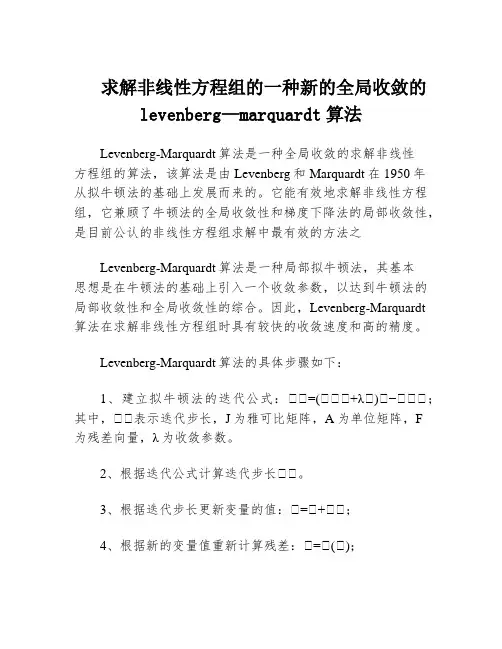
求解非线性方程组的一种新的全局收敛的levenberg—marquardt算法
Levenberg-Marquardt算法是一种全局收敛的求解非线性
方程组的算法,该算法是由Levenberg和Marquardt在1950年
从拟牛顿法的基础上发展而来的。
它能有效地求解非线性方程组,它兼顾了牛顿法的全局收敛性和梯度下降法的局部收敛性,是目前公认的非线性方程组求解中最有效的方法之
Levenberg-Marquardt算法是一种局部拟牛顿法,其基本
思想是在牛顿法的基础上引入一个收敛参数,以达到牛顿法的局部收敛性和全局收敛性的综合。
因此,Levenberg-Marquardt
算法在求解非线性方程组时具有较快的收敛速度和高的精度。
Levenberg-Marquardt算法的具体步骤如下:
1、建立拟牛顿法的迭代公式:DD=(DDD+λD)D−DDD;其中,DD表示迭代步长,J为雅可比矩阵,A为单位矩阵,F
为残差向量,λ为收敛参数。
2、根据迭代公式计算迭代步长DD。
3、根据迭代步长更新变量的值:D=D+DD;
4、根据新的变量值重新计算残差:D=D(D);
5、检查收敛情况,如果迭代收敛,则结束;如果未收敛,则更新收敛参数λ,重复步骤1~
4,直到收敛结束。
Levenberg-Marquardt算法是一种全局收敛的求解非线性
方程组的算法,它能够有效地求解非线性方程组,是目前公认的求解非线性方程组的最有效方法之
一。
它在求解非线性方程组时,兼顾了牛顿法的全局收敛性和梯度下降法的局部收敛性,使得它在求解非线性方程组时具有较快的收敛速度和高的精度。
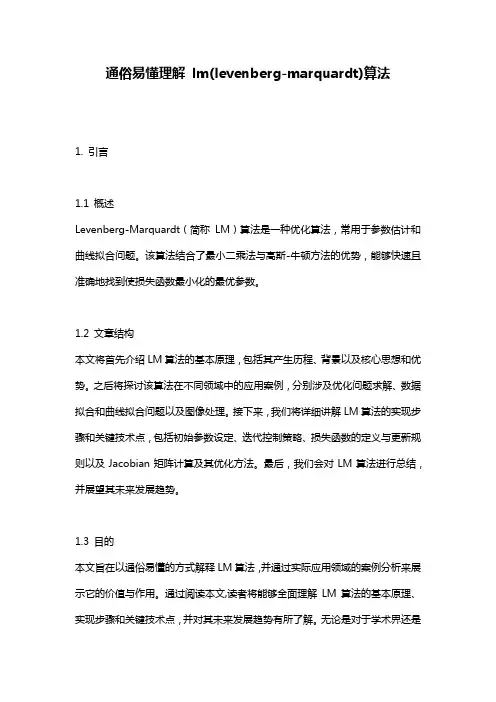
通俗易懂理解lm(levenberg-marquardt)算法1. 引言1.1 概述Levenberg-Marquardt(简称LM)算法是一种优化算法,常用于参数估计和曲线拟合问题。
该算法结合了最小二乘法与高斯-牛顿方法的优势,能够快速且准确地找到使损失函数最小化的最优参数。
1.2 文章结构本文将首先介绍LM算法的基本原理,包括其产生历程、背景以及核心思想和优势。
之后将探讨该算法在不同领域中的应用案例,分别涉及优化问题求解、数据拟合和曲线拟合问题以及图像处理。
接下来,我们将详细讲解LM算法的实现步骤和关键技术点,包括初始参数设定、迭代控制策略、损失函数的定义与更新规则以及Jacobian矩阵计算及其优化方法。
最后,我们会对LM算法进行总结,并展望其未来发展趋势。
1.3 目的本文旨在以通俗易懂的方式解释LM算法,并通过实际应用领域的案例分析来展示它的价值与作用。
通过阅读本文,读者将能够全面理解LM算法的基本原理、实现步骤和关键技术点,并对其未来发展趋势有所了解。
无论是对于学术界还是工程领域,LM算法都具有重要的意义和应用价值,掌握该算法将为读者在相关领域中的研究和工作提供有力支持。
2. lm算法的基本原理:2.1 生产历程和背景Levenberg-Marquardt(LM)算法是用于非线性最小二乘问题求解的优化算法。
它起源于20世纪40年代,由K.A. Levenberg和D.W.H. Marquardt分别提出并发展而来。
LM算法在处理非线性优化问题上表现出色,因此被广泛应用于各个领域,如数据拟合、曲线拟合和图像处理等。
2.2 算法思想及优势LM算法的核心思想是将高效的最速下降法(steepest descent method)和牛顿法(Newton's method)结合起来,以克服两者在不同情况下的局限性。
它通过调整一个控制参数(称为阻尼因子)的大小来控制最速下降法和牛顿法之间的权衡。
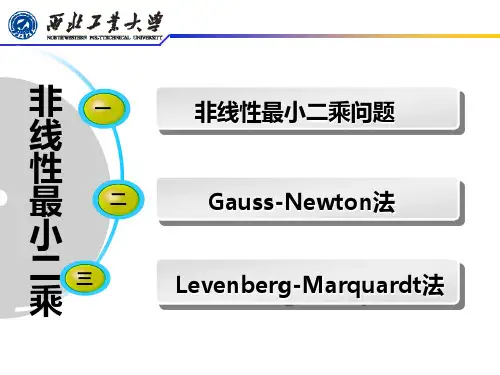
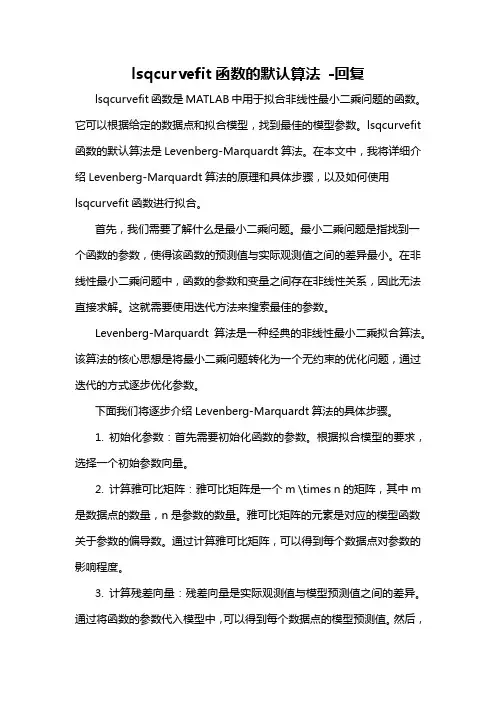
lsqcurvefit函数的默认算法-回复lsqcurvefit函数是MATLAB中用于拟合非线性最小二乘问题的函数。
它可以根据给定的数据点和拟合模型,找到最佳的模型参数。
lsqcurvefit 函数的默认算法是Levenberg-Marquardt算法。
在本文中,我将详细介绍Levenberg-Marquardt算法的原理和具体步骤,以及如何使用lsqcurvefit函数进行拟合。
首先,我们需要了解什么是最小二乘问题。
最小二乘问题是指找到一个函数的参数,使得该函数的预测值与实际观测值之间的差异最小。
在非线性最小二乘问题中,函数的参数和变量之间存在非线性关系,因此无法直接求解。
这就需要使用迭代方法来搜索最佳的参数。
Levenberg-Marquardt算法是一种经典的非线性最小二乘拟合算法。
该算法的核心思想是将最小二乘问题转化为一个无约束的优化问题,通过迭代的方式逐步优化参数。
下面我们将逐步介绍Levenberg-Marquardt算法的具体步骤。
1. 初始化参数:首先需要初始化函数的参数。
根据拟合模型的要求,选择一个初始参数向量。
2. 计算雅可比矩阵:雅可比矩阵是一个m \times n的矩阵,其中m 是数据点的数量,n是参数的数量。
雅可比矩阵的元素是对应的模型函数关于参数的偏导数。
通过计算雅可比矩阵,可以得到每个数据点对参数的影响程度。
3. 计算残差向量:残差向量是实际观测值与模型预测值之间的差异。
通过将函数的参数代入模型中,可以得到每个数据点的模型预测值。
然后,计算实际观测值与模型预测值之间的差异。
4. 计算雅可比矩阵的转置矩阵:为了后续计算,需要计算雅可比矩阵的转置矩阵。
5. 计算增量向量:根据以下公式计算增量向量:(J^T J + \lambda I) \Delta P = J^T r其中,J^T是雅可比矩阵的转置矩阵,\lambda是一个调节因子,I是单位矩阵,\Delta P是参数的增量向量,r是残差向量。
Levenberg-Marquardt法是一种非线性最小二乘法的优化算法,用于拟合数学模型和参数估计。
它结合了最速下降法和高斯-牛顿法的特点,旨在寻找使模型的预测值与观测值之间残差平方和最小的参数。
以下是Levenberg-Marquardt法的基本原理和步骤:
定义目标函数:
将拟合问题转化为目标函数最小化的问题。
目标函数是通过数学模型计算的预测值与观测值之间的差异(残差)的平方和。
初始化参数:
为模型中的参数设置初始值。
迭代优化:
a. 计算雅可比矩阵:
根据当前参数值计算目标函数对各个参数的偏导数,形成雅可比矩阵。
b. 计算近似Hessian矩阵:
根据雅可比矩阵计算近似Hessian矩阵,用于近似目标函数的二次形式。
c. 更新参数:
根据近似Hessian矩阵和梯度信息,更新当前参数值。
根据问题的不同,可能使用Levenberg-Marquardt法的调整因子(lambda)来平衡最速下降和高斯-牛顿步骤。
d. 检查终止条件:
检查参数更新的大小,如果满足终止条件(如参数变化小于某个阈值),则停止迭代;否则,返回步骤a。
Levenberg-Marquardt法通过迭代优化的过程,逐步调整参数值,使目标函数达到最小值。
它在参数估计和曲线拟合等问题中被广泛应用,特别适用于非线性模型和数据带有噪声的情况。
levenberg-marquardt算法拟合椭球误差方程matlab 1. 引言1.1 概述在计算机科学和数学领域,拟合问题是一种常见的数值优化任务,其目标是通过寻找一个函数或者数学模型来最好地逼近给定的数据集。
椭球误差方程作为一种重要的拟合问题,在多个领域中都有广泛的应用,比如地理测量、图像处理等。
椭球误差方程拟合问题旨在使用已知的数据点来确定一个椭球表面,从而使得与实际观测值之间的误差最小化。
1.2 文章结构本文将系统地讨论Levenberg-Marquardt算法在拟合椭球误差方程中的应用。
首先,我们将介绍Levenberg-Marquardt算法的原理和特点,并探讨其在优化问题中的优势和局限性。
然后,我们将详细说明椭球误差方程模型以及相关参数的获取和预处理方法。
接下来,我们将介绍如何使用Levenberg-Marquardt 算法进行椭球误差方程的拟合,并分析其效果与收敛性能。
最后,我们将设计实验并对结果进行分析和讨论,并提出一些改进方法与展望。
1.3 目的本文旨在探究和研究Levenberg-Marquardt算法在椭球误差方程拟合问题中的适用性和效果。
通过实验证明该算法在解决这一特定问题上的优势,并且为相关领域的研究提供一定的参考和借鉴。
同时,本文也希望找出使用Levenberg-Marquardt算法拟合椭球误差方程存在的问题与局限性,并对后续工作提出展望,以进一步改进和完善该方法在实际应用中的效果。
2. Levenberg-Marquardt算法:2.1 算法原理:Levenberg-Marquardt算法是一种非线性最小二乘拟合算法,常用于解决参数问题的拟合。
该算法的目标是通过调整参数值,使得误差函数的平方和最小化。
它结合了高斯-牛顿方法和梯度下降法的优点,通过引入一个阻尼因子来平衡两者之间的权衡。
算法的核心思想是在每次迭代过程中,根据当前参数值计算误差函数的梯度矩阵和雅可比矩阵,并通过求解一个增量方程获得新的参数估计值。
levenberg–marquardt算法Levenberg-Marquardt 算法是一种非线性最小二乘优化算法,常用于求解非线性最小二乘问题。
它是在1963 年由Levenberg 和Marquardt 分别独立提出的。
算法基本思想是通过迭代的方式逐步逼近问题的最优解。
在每一次迭代中,算法首先根据当前估计值计算出目标函数的雅可比矩阵和海森矩阵,然后利用这两个矩阵来更新估计值。
如果更新后的估计值比当前估计值更接近最优解,则接受更新;否则,将更新后的估计值回退一定比例,以避免过大的更新导致算法发散。
以下是Levenberg-Marquardt 算法的基本步骤:1.初始化:选择一个初始的估计值x0,以及一个正的初始权重矩阵H0。
2.在每一次迭代中,根据当前的估计值x 和权重矩阵H,计算出目标函数的雅可比矩阵J 和海森矩阵H。
3.使用雅可比矩阵J 和海森矩阵H 来计算出目标函数的梯度g = J' * H * J * x + J' * H* lambda,其中lambda 是用于控制权重矩阵H 的一个向量。
4.计算出梯度g 的范数||g||,如果||g|| < tol(其中tol 是预先设定的一个很小的正数),则停止迭代;否则,继续下一步。
5.使用梯度g 和海森矩阵H 来计算出下一次迭代的估计值xnew。
6.如果更新后的估计值xnew 比当前估计值x 更接近最优解,则接受更新,即x =xnew;否则,将更新后的估计值回退一定比例,即x = x - alpha * (xnew - x),其中alpha 是一个正的回退因子。
7.更新权重矩阵H,如果||gnew|| < ||g||,则将H 乘以一个小于1 的因子;否则,将H 乘以一个大于1 的因子。
8.返回步骤2,继续下一次迭代。
总的来说,Levenberg-Marquardt 算法是一种非常有效的非线性最小二乘优化算法,适用于求解各种非线性最小二乘问题。
matlab中levenberg-marquardt method -回复Levenberg-Marquardt算法是一种非线性最小二乘优化算法,主要用于拟合数据和参数估计。
本文将详细介绍Levenberg-Marquardt算法的原理、步骤和应用,并附上一些在MATLAB中使用该算法的示例代码。
一、Levenberg-Marquardt算法的原理Levenberg-Marquardt算法是由K.A. Levenberg和D.W. Marquardt 于20世纪60年代提出的。
它通过将高阶泰勒展开中的二次项引入到标准的Gauss-Newton算法中,从而在参数估计过程中更准确地逼近最优解。
该算法基于以下原理:1.1 高斯-牛顿法Levenberg-Marquardt算法是基于高斯-牛顿法的一种改进算法。
高斯-牛顿法是一种迭代的最小二乘优化算法,通过迭代更新参数直到满足一定的收敛条件。
它利用目标函数的雅可比矩阵(Jacobian matrix)和残差向量(residual vector)来进行优化。
1.2 问题建模在应用Levenberg-Marquardt算法之前,我们首先需要建立一个数学模型来描述实际问题。
这个模型通常是一个非线性方程或函数,可以用来表示我们需要拟合的数据或估计的参数。
1.3 误差函数和最小化目标Levenberg-Marquardt算法的目标是通过最小化误差函数来找到最优解。
误差函数通常是实际观测数据与数学模型之间的差异,我们希望通过调整参数来使误差最小化。
二、Levenberg-Marquardt算法的步骤接下来,我们将介绍Levenberg-Marquardt算法的具体步骤。
这些步骤将帮助我们理解该算法的实现过程。
2.1 初始化参数首先,我们需要初始化参数向量。
这些参数通常是我们需要拟合或估计的未知数,可以是常数、系数或其他变量。
2.2 构建残差向量和雅可比矩阵在每次迭代过程中,我们需要构建残差向量和雅可比矩阵。
lm算法matlab程序在lm算法matlab程序的编写过程中,我们需要先了解lm算法的基本原理和步骤,然后结合matlab语言特点进行具体实现。
下面将介绍lm算法的基本原理和在matlab中的程序编写步骤。
一、lm算法基本原理lm算法,全称Levenberg-Marquardt算法,是一种参数优化算法。
它主要用于非线性最小二乘问题的求解,通过调整参数的方式使得参数值能够最小化目标函数的误差。
该算法结合了高斯-牛顿法和最速下降法的优点,既能够收敛速度较快,又能够获得较精确的参数估计。
lm算法的基本思想是通过不断迭代调整参数值,使得目标函数的误差逐渐减小。
具体而言,它通过计算雅可比矩阵(Jacobian matrix)和李方差矩阵(Levenberg-Marquardt matrix)来更新参数值。
在每一次迭代中,首先计算目标函数的梯度,然后根据梯度和李方差矩阵的乘积来调整参数值。
如果调整后的参数值能够使目标函数的误差减小,则接受该调整并继续下一轮迭代;否则,减小李方差矩阵的乘积,再次尝试调整参数值。
总的来说,lm算法是一种迭代优化算法,通过不断更新参数值来求解非线性最小二乘问题。
接下来我们将具体介绍在matlab中如何编写lm算法的程序。
二、matlab程序编写步骤在matlab中,编写lm算法的程序主要包括以下几个步骤:1. 定义目标函数:首先要定义一个目标函数,它是一个关于参数的函数,用来计算目标函数的值。
可以根据具体的问题定义不同的目标函数,例如,可以定义一个二次函数作为目标函数。
2. 初始化参数:在开始迭代之前,需要给参数赋初值。
初值的选择通常是根据经验和问题的特点来确定的,可以根据实际情况进行调整。
3. 迭代计算:迭代计算是lm算法的核心部分。
在每一次迭代中,需要计算目标函数的梯度和李方差矩阵的乘积,并根据结果来更新参数值。
4. 判断终止条件:在进行迭代计算的过程中,需要不断判断是否满足终止条件。
Levenberg-Marquardt Method(麦夸尔特法)Levenberg-Marquardt is a popular alternative to the Gauss-Newton method of finding the minimum of afunction that is a sum of squares of nonlinear functions,Let the Jacobian of be denoted , then the Levenberg-Marquardt method searches in thedirection given by the solution to the equationswhere are nonnegative scalars and is the identity matrix. The method has the nice property that, forsome scalar related to , the vector is the solution of the constrained subproblem of minimizingsubject to (Gill et al. 1981, p. 136).The method is used by the command FindMinimum[f, x, x0] when given the Method -> Levenberg Marquardt option.SEE A LSO:Minimum, OptimizationREFERENCES:Bates, D. M. and Watts, D. G. N onlinear Regr ession and Its Applications. New York: Wiley, 1988.Gill, P. R.; Murray, W.; and Wright, M. H. "The Levenberg-Marquardt Method." §4.7.3 in Practical Optim ization. London: Academic Press, pp. 136-137, 1981.Levenberg, K. "A Method for the Solution of Certain Problems in Least Squares." Quart. Appl. Math.2, 164-168, 1944. Marquardt, D. "An Algor ithm for Least-Squares Estimation of Nonlinear Parameters." SIAM J. Appl. Math.11, 431-441, 1963.Levenberg–Marquardt algorithmFrom Wikipedia, the free encyclopediaJump to: navigation, searchIn mathematics and computing, the Levenberg–Marquardt algorithm (LMA)[1] provides a numerical solution to the problem of minimizing a function, generally nonlinear, over a space of parameters of the function. These minimization problems arise especially in least squares curve fitting and nonlinear programming.The LMA interpolates between the Gauss–Newton algorithm (GNA) and the method of gradient descent. The LMA is more robust than the GNA, which means that in many cases it finds a solution even if it starts very far off the final minimum. For well-behaved functions and reasonable starting parameters, the LMA tends to be a bit slower than the GNA. LMA can also be viewed as Gauss–Newton using a trust region approach.The LMA is a very popular curve-fitting algorithm used in many software applications for solving generic curve-fitting problems. However, the LMA finds only a local minimum, not a global minimum.Contents[hide]∙ 1 Caveat Emptor∙ 2 The problem∙ 3 The solutiono 3.1 Choice of damping parameter∙ 4 Example∙ 5 Notes∙ 6 See also∙7 References∙8 External linkso8.1 Descriptionso8.2 Implementations[edit] Caveat EmptorOne important limitation that is very often over-looked is that it only optimises for residual errors in the dependant variable (y). It thereby implicitly assumes that any errors in the independent variable are zero or at least ratio of the two is so small as to be negligible. This is not a defect, it is intentional, but it must be taken into account when deciding whether to use this technique to do a fit. While this may be suitable in context of a controlled experiment there are many situations where this assumption cannot be made. In such situations either non-least squares methods should be used or the least-squares fit should be done in proportion to the relative errors in the two variables, not simply the vertical "y" error. Failing to recognise this can lead to a fit which is significantly incorrect and fundamentally wrong. It will usually underestimate the slope. This may or may not be obvious to the eye.MicroSoft Excel's chart offers a trend fit that has this limitation that is undocumented. Users often fall into this trap assuming the fit is correctly calculated for all situations. OpenOffice spreadsheet copied this feature and presents the same problem.[edit] The problemThe primary application of the Levenberg–Marquardt algorithm is in the least squares curve fitting problem: given a set of m empirical datum pairs of independent and dependent variables, (x i, y i), optimize the parameters β of the model curve f(x,β) so that the sum of the squares of the deviationsbecomes minimal.[edit] The solutionLike other numeric minimization algorithms, the Levenberg–Marquardt algorithm is an iterative procedure. To start a minimization, the user has to provide an initial guess for the parameter vector, β. In many cases, an uninformed standard guess like βT=(1,1,...,1) will work fine;in other cases, the algorithm converges only if the initial guess is already somewhat close to the final solution.In each iteration step, the parameter vector, β, is replaced by a new estimate, β + δ. To determine δ, the functions are approximated by their linearizationswhereis the gradient(row-vector in this case) of f with respect to β.At its minimum, the sum of squares, S(β), the gradient of S with respect to δwill be zero. The above first-order approximation of gives.Or in vector notation,.Taking the derivative with respect to δand setting theresult to zero gives:where is the Jacobian matrix whose i th row equals J i,and where and are vectors with i th componentand y i, respectively. This is a set of linear equations which can be solved for δ.Levenberg's contribution is to replace this equation by a "damped version",where I is the identity matrix, giving as the increment, δ, to the estimated parameter vector, β.The (non-negative) damping factor, λ, isadjusted at each iteration. If reduction of S is rapid, a smaller value can be used, bringing the algorithm closer to the Gauss–Newton algorithm, whereas if an iteration gives insufficientreduction in the residual, λ can be increased, giving a step closer to the gradient descentdirection. Note that the gradient of S withrespect to β equals .Therefore, for large values of λ, the step will be taken approximately in the direction of the gradient. If either the length of the calculated step, δ, or the reduction of sum of squares from the latest parameter vector, β + δ, fall below predefined limits, iteration stops and the last parameter vector, β, is considered to be the solution.Levenberg's algorithm has the disadvantage that if the value of damping factor, λ, is large, inverting J T J + λI is not used at all. Marquardt provided the insight that we can scale eachcomponent of the gradient according to thecurvature so that there is larger movement along the directions where the gradient is smaller. This avoids slow convergence in the direction of small gradient. Therefore, Marquardt replaced theidentity matrix, I, with the diagonal matrixconsisting of the diagonal elements of J T J,resulting in the Levenberg–Marquardt algorithm:.A similar damping factor appears in Tikhonov regularization, which is used to solve linear ill-posed problems, as well as in ridge regression, an estimation technique in statistics.[edit] Choice of damping parameterVarious more-or-less heuristic arguments have been put forward for the best choice for the damping parameter λ. Theoretical arguments exist showing why some of these choices guaranteed local convergence of the algorithm; however these choices can make the global convergence of the algorithm suffer from the undesirable properties of steepest-descent, in particular very slow convergence close to the optimum.The absolute values of any choice depends on how well-scaled the initial problem is. Marquardt recommended starting with a value λ0 and a factor ν>1. Initially setting λ=λ0and computing the residual sum of squares S(β) after one step from the starting point with the damping factor of λ=λ0 and secondly withλ0/ν. If both of these are worse than the initial point then the damping is increased by successive multiplication by νuntil a better point is found with a new damping factor of λ0νk for some k.If use of the damping factor λ/ν results in a reduction in squared residual then this is taken as the new value of λ (and the new optimum location is taken as that obtained with this damping factor) and the process continues; if using λ/ν resulted in a worse residual, but using λresulted in a better residual then λ is left unchanged and the new optimum is taken as the value obtained with λas damping factor.[edit] ExamplePoor FitBetter FitBest FitIn this example we try to fit the function y = a cos(bX) + b sin(aX) using theLevenberg–Marquardt algorithm implemented in GNU Octave as the leasqr function. The 3 graphs Fig 1,2,3 show progressively better fitting for the parameters a=100, b=102 used in the initial curve. Only when the parameters in Fig 3 are chosen closest to the original, are thecurves fitting exactly. This equation is an example of very sensitive initial conditions for the Levenberg–Marquardt algorithm. One reason for this sensitivity is the existenceof multiple minima —the function cos(βx)has minima at parameter value and[edit] Notes1.^ The algorithm was first published byKenneth Levenberg, while working at theFrankford Army Arsenal. It was rediscoveredby Donald Marquardt who worked as astatistician at DuPont and independently byGirard, Wynn and Morrison.[edit] See also∙Trust region[edit] References∙Kenneth Levenberg(1944). "A Method for the Solution of Certain Non-Linear Problems in Least Squares". The Quarterly of Applied Mathematics2: 164–168.∙ A. Girard (1958). Rev. Opt37: 225, 397. ∙ C.G. Wynne (1959). "Lens Designing by Electronic Digital Computer: I". Proc.Phys. Soc. London73 (5): 777.doi:10.1088/0370-1328/73/5/310.∙Jorje J. Moré and Daniel C. Sorensen (1983)."Computing a Trust-Region Step". SIAM J.Sci. Stat. Comput. (4): 553–572.∙ D.D. Morrison (1960). Jet Propulsion Laboratory Seminar proceedings.∙Donald Marquardt (1963). "An Algorithm for Least-Squares Estimation of NonlinearParameters". SIAM Journal on AppliedMathematics11 (2): 431–441.doi:10.1137/0111030.∙Philip E. Gill and Walter Murray (1978)."Algorithms for the solution of thenonlinear least-squares problem". SIAMJournal on Numerical Analysis15 (5):977–992. doi:10.1137/0715063.∙Nocedal, Jorge; Wright, Stephen J. (2006).Numerical Optimization, 2nd Edition.Springer. ISBN0-387-30303-0.[edit] External links[edit] Descriptions∙Detailed description of the algorithm can be found in Numerical Recipes in C, Chapter15.5: Nonlinear models∙ C. T. Kelley, Iterative Methods for Optimization, SIAM Frontiers in AppliedMathematics, no 18, 1999, ISBN0-89871-433-8. Online copy∙History of the algorithm in SIAM news∙ A tutorial by Ananth Ranganathan∙Methods for Non-Linear Least Squares Problems by K. Madsen, H.B. Nielsen, O.Tingleff is a tutorial discussingnon-linear least-squares in general andthe Levenberg-Marquardt method inparticular∙T. Strutz: Data Fitting and Uncertainty (A practical introduction to weighted least squares and beyond). Vieweg+Teubner, ISBN 978-3-8348-1022-9.[edit] Implementations∙Levenberg-Marquardt is a built-in algorithm with Mathematica∙Levenberg-Marquardt is a built-in algorithm with Matlab∙The oldest implementation still in use is lmdif, from MINPACK, in Fortran, in thepublic domain. See also:o lmfit, a translation of lmdif into C/C++ with an easy-to-use wrapper for curvefitting, public domain.o The GNU Scientific Library library hasa C interface to MINPACK.o C/C++ Minpack includes theLevenberg–Marquardt algorithm.o Several high-level languages andmathematical packages have wrappers forthe MINPACK routines, among them:▪Python library scipy, modulescipy.optimize.leastsq,▪IDL, add-on MPFIT.▪R (programming language) has theminpack.lm package.∙levmar is an implementation in C/C++ with support for constraints, distributed under the GNU General Public License.o levmar includes a MEX file interface for MATLABo Perl (PDL), python and Haskellinterfaces to levmar are available: seePDL::Fit::Levmar, PyLevmar andHackageDB levmar.∙sparseLM is a C implementation aimed at minimizing functions with large,arbitrarily sparse Jacobians. Includes a MATLAB MEX interface.∙ALGLIB has implementations of improved LMA in C# / C++ / Delphi / Visual Basic.Improved algorithm takes less time toconverge and can use either Jacobian orexact Hessian.∙NMath has an implementation for the .NET Framework.∙gnuplot uses its own implementation .∙Java programming language implementations:1) Javanumerics, 2) LMA-package (a small,user friendly and well documentedimplementation with examples and support),3) Apache Commons Math∙OOoConv implements the L-M algorithm as an Calc spreadsheet.∙SAS, there are multiple ways to access SAS's implementation of the Levenberg-Marquardt algorithm: it can be accessed via NLPLMCall in PROC IML and it can also be accessed through the LSQ statement in PROC NLP, and the METHOD=MARQUARDT option in PROC NLIN.。